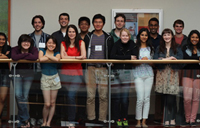
Twenty-four students from Canada and the United States are taking part in a week-long vision science program at York University designed, in part, to recruit top graduate students to York University’s Centre for Vision Research.
The internationally renowned CVR is comprised of a core group of 30 scientists in the Department of Psychology, the School of Kinesiology & Health Studies in the Faculty of Health, the Departments of Biology and Physics in the Faculty of Science, and the Department of Computer Science in the Lassonde School of Engineering.

Twenty-four students from schools across Canada and the United States are at York University this week to take part in the Centre For Vision Research summer school
"We are interested in promoting the Centre for Vision Research to these high-calibre students who may be potential graduate school applicants in the following year," said York psychology Professor Jennifer Steeves, who organized the summer school with her colleague Richard Murray, also a professor of psychology in York’s Faculty of Health.
Third-year undergraduate students from universities spanning coast to coast, from Memorial University of Newfoundland and the University of British Columbia are joining six students from across the United States, including Carnegie Mellon University and the University of Southern California. Students were selected from over 100 applicants from around the world.
The program curriculum reflects the diverse on-going research projects at the centre, including studies on the visual perception of light, shape and objects, the neural circuitry of visual memory and attention, as well as applied topics in virtual reality, robotics, visuomotor interfaces and clinical aspects of vision.
"We wanted to find students that would fit the whole span of disciplines we have at the Centre for Vision Research, from computer science to psychology, to kinesiology and more," added Steeves.
“Students will be hands-on participants in CVR laboratories, studying a wide range of topics, including how we interact with and manipulate objects in our environment, how we recognize faces, and how we see in three dimensions,” said Steeves.
Many of the sessions will highlight research and technology that most undergraduate science students will not have been exposed to before. One such piece of equipment is York's Tumbling Room. The Tumbling Room lab is an 8-foot cube resembling a typical room except that it can be rotated around a stationary subject or a subject can be rotated within the stationary room. By manipulating various visual and gravitational cues, students will be able to quantify subjects' perceptions of their own orientation.
Students will have the opportunity to experience a brain scan in the new MRI facility in the Sherman Health Science Research Centre. They will observe cutting-edge brain stimulation technology that can transiently interrupt mental processing, allowing a better understanding of how the brain works.
In the 3DFlic lab, students will participate in a state-of-the-art stereoscopic 3D lab which is aimed to push the boundaries of the experience and technology of 3D film.
The Vision Science Summer School is now in its seventh year. It is funded by a training grant from the Natural Sciences and Engineering Research Council of Canada's CREATE program and several vice presidents’ and dean's offices at York University.
The summer school is running this week, June 3 to 7, in Lassonde 3033 as well as in various CVR labs across York's Keele campus.
